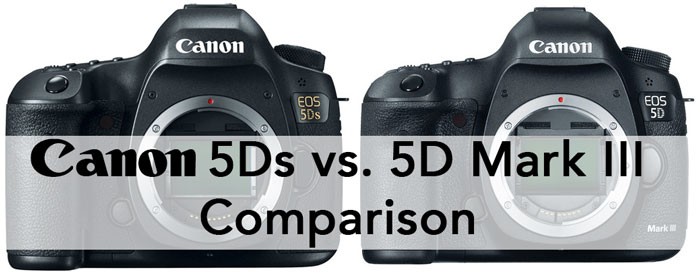When Canon announced the new 5Ds and 5Ds R cameras, it stoked the megapixel war flames once again by thoroughly trouncing the resolution of the Nikon D810 and Sony A7R cameras, both of which offer a mere 36MP full frame sensor.
While the 5Ds and 5Ds R are the latest to the 5D line, Canon is leaving the very popular 5D Mark III in the line-up. The Canon 5D Mark III was introduced in March 2012. By Canon’s prior timelines, the 3-year point is the proper upgrade timeframe. However, DSLRs have plateaued somewhat over the past few years and the need to upgrade every 2-3 years is less compelling for photographers and, by extension, camera manufacturers.
Additionally, the 5D Mark III and 5Ds/5Ds R are, in many ways, very different cameras for very different purposes. Even though the cameras are very similar from the outside, what’s inside makes them very different indeed.
The Canon 5D Mark III is a low light machine, while the 5Ds and 5Ds R were stated at their announcement to precisely not be intended for low light use. The specifications echo that sentiment with the 5Ds models only rated to ISO 6400 (and ISO 12,800 by expansion).
Additionally, even though they are capable of shooting HD video, the 5Ds models are not heralded as video machines like the 5D Mark III has been. The Canon 5Ds does not include a clean, uncompressed HDMI output signal as is found in the 5D Mark III. Canon cites the increased resolution and the propensity for significant moire as a reason to pull it from the 5Ds and 5Ds R. Additionally, the 5Ds models do not offer a headphone output to monitor on-board audio; a feature which is also found in the 5D Mark III.
Canon 5Ds and 5D Mark III Specification Comparison
| Canon 5Ds | Canon 5D Mark III | |
| Resolution | 50.6MP | 22.1MP |
| Pixel Pitch | 4.14 µm square | 6.25 µm square |
| Processor | Dual DIGIC 6 | DIGIC 5+ |
| AF Points | 61-points (41 cross-type) | 61-points (41 cross-type) |
| Sensitivity | ISO 100-6400 (ISO 50-12,800 expansion) | ISO 100-25,600 (ISO 50-102,400 expansion) |
| Frame Rate | up to 5fps | up to 6fps |
| Viewfinder | 100% field of view / 0.71x magnification | 100% field of view / 0.71x magnification |
| Video Resolution | 1920 x 1080p at 30p/25p/24p with ALL-I or IPB codecs | 1920 x 1080p at 30p/25p/24p with ALL-I or IPB codecs |
| Time Lapse Movie Mode | Yes | No |
| Display | 3.2” LCD at 1.04M-dot res | 3.2” LCD at 1.04M-dot res |
| Storage | CF (UDMA 7) & SD (UHS-I) | CF (UDMA 7) & SD |
| Crop Mode | 1.3x & 1.6x | N/A |
| Intervalometer | Yes | Optional remote required |
| Anti-flicker | Yes | N/A |
| Metering | 150,000-pixel RGB+IR; 252-zone TTL metering | Dual layer 63-zone iFCL metering sensor |
| Shutter Speed | 30s-1/8000s | 30s-1/8000s |
| X-Sync | 1/200s | 1/200s |
| Exposure Compensation | +/-5 stops | +/-5 stops |
| HDMI | Mini-HDMI output (no clean output) | Mini-HDMI w/ clean, uncompressed output |
| Headphone Out | No | Yes |
| USB | USB 3.0 | USB 2.0 |
| Battery | LP-E6N / LP-E6 | LP-E6N / LP-E6 |
| Size | 152 x 116.4 x 76.4mm | 152 x 116.4 x 76.4mm |
| Weight | 930g (CIPA standards) / 845g (body only) | 950g (CIPA standards) / 860g (Body only) |
It is clear that Canon continues to split the market so as not to impede the sales of its other products. As it stands now, there is still a compelling reason for the 5D Mark III to remain on the market. Simply looking at the spec list for each of the cameras you can see that the 5Ds and 5Ds R enjoy a position as a camera for the stills photographer, while the 5D Mark III remains an all-purpose stills and video camera that can shoehorn its way into a variety of circumstances.
In 2015, it is easy to scoff at the 5D Mark III and its full frame sensor with only 22MP; however, we have come a long way in the past decade. 22MP was in the stratosphere of our imaginations in 2005. Now, it is available in a high-level pro camera for around $2500. While consumer-grade DSLRs are offering 25MP-ish sensors as well, the 5D Mark III’s full frame sensor and other features put it a few steps above just the megapixel rating. And, again, we are talking about 22 million pixels of information that make up a single photograph.
The $3700 asking price for the Canon 5Ds (and $3900 for the 5Ds R) comes with the unmentioned expense on the spec sheet . . . high-end pro lenses that are capable of resolving at 50MP. We really shouldn’t deliver a lot of complaints about the price tag of these two cameras because the body is not the cost that is going to hurt – the lenses are.
The Canon 5Ds and 5Ds R are now available for pre-order for delivery in June 2015. Check them out in more detail and get in the pre-order line here at B&H Photo.
Stay tuned for more covered on the Canon 5Ds and 5Ds R.



Use DSLRs professionally —- also own Fuji x-t1 plus large range of Fuji lenses but disappointed by slow focus in comparison to DSLRs
Glad to see that they finally included a decent SD card reader. I can’t stand how slow it is on the 5D Mk3.
Agreed. That was a real unfortunate misstep with the 5D Mark III.
Even though I am pretty heavily invested in Canon, I have been very tempted by the Nikon 800E and 810 for landscape, not just because of the resolution (you can do that with panoramic shots if you really need it if things aren’t moving), but also because of the dynamic range (DR) of the sensor.
This may redirect my interest back to Canon, but seems to me like they took too big of a jump from 22 MPs. I think a 35-40 MP sensor would have been plenty and still maintain a little more of that low light sensitivity / signal to noise. I hope the DR of the sensor doesn’t get any worse, and would be nice if it made some improvements in that area. Also wish they had removed the filter instead of cancelling the effect. Nikon and Sony have both already done that.
Can’t wait to see how the tests come out. At least Canon has several good lenses to take advantage of the higher res. Thanks for the good info.
I skipped the mark iii but plan to get the 5Ds. I love big images and do a lot of pixel level editing. I could care less about low light. I always shoot at ISO 100. Don’t care about sports, action or video so the 5Ds sounds great. I’m happy that they didn’t go to a thin mirrorless design too so that I can use my EF L lenses without adapters. I’m a little set back though that WiFi is a $700 add on though when it’s built into every decent point and shoot. But maybe it does more during the shoot. Time will tell.
I’m with you Gary. I was unimpressed with the limited improvements of the Mkiii. Certainly advanced autofocus is not enough to justify a $1000 price hike over the 5d mkii.